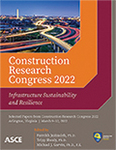Assessment of the Relative Importance of the Main Parameters Used in the Selection of the Urban Heat Island Mitigation Strategies
Publication: Construction Research Congress 2022
ABSTRACT
Resilient and sustainable development of urban areas under climate change requires strategies to compensate for the effects of the urban heat island (UHI). Currently, there are various urban heat island mitigation strategies (UHIMSs) used to alleviate the impact of the ever-rising temperatures. However, the effectiveness of such strategies should be assessed with respect to a multitude of parameters to ensure their resilience and sustainability. The review of the literature reveals there is lack of comprehensive models and clear performance measures that can aid practitioners in selecting the most appropriate mitigation method(s). This study presents a framework of a comprehensive model that incorporates the most common sustainable and resilience attributes and criteria. This work represents the skeleton needed to further develop an interactive computer-based decision support system (DSS) for selecting the most efficient UHIMS with respect to the preset criteria based on the resilience and strategy of the UHIMS considered.
Get full access to this article
View all available purchase options and get full access to this chapter.
REFERENCES
Akbari, H., and Konopacki, S. (2005). Calculating energy-saving potentials of heat-island reduction strategies. Energy Policy, 33(6), 721–756. https://doi.org/10.1016/j.enpol.2003.10.001.
Aloisio, J. M. (2017). Rooftop plants: Community and nutrient dynamics of New York City green roofs [Ph.D., Fordham University]. https://search.proquest.com/pqdtglobal/docview/1878206725/abstract/129B7FFB5D6D4B8DPQ/47.
Bathaei, B., and Abdel-Raheem, M. (2021). Parameters Affecting Selection of the mitigation Strategies of Heat Island Effect. Proceedings of the Canadian Society of Civil Engineering Annual Conference 2021. Inspired by Nature, Canada-in Press.
Busato, F., Lazzarin, R. M., and Noro, M. (2014). Three years of study of the Urban Heat Island in Padua: Experimental results. Sustainable Cities and Society, 10, 251–258. https://doi.org/10.1016/j.scs.2013.05.001.
Gibler, M. R. (2015). Comprehensive benefits of green roofs [M.S., Missouri University of Science and Technology]. https://search.proquest.com/pqdtglobal/docview/1698104072/abstract/129B7FFB5D6D4B8DPQ/26.
Harlan, S. L., Brazel, A. J., Prashad, L., Stefanov, W. L., and Larsen, L. (2006). Neighborhood microclimates and vulnerability to heat stress. Social Science & Medicine, 63(11), 2847–2863. https://doi.org/10.1016/j.socscimed.2006.07.030.
Kazak, J. K. (2018). The Use of a Decision Support System for Sustainable Urbanization and Thermal Comfort in Adaptation to Climate Change Actions—The Case of the Wrocław Larger Urban Zone (Poland). Sustainability, 10(4), 1083. https://doi.org/10.3390/su10041083.
Khamchiangta, D., and Dhakal, S. (2019). Physical and non-physical factors driving urban heat island: Case of Bangkok Metropolitan Administration, Thailand. J. Environ. Manage, 248, 109285. https://doi.org/10.1016/j.jenvman.2019.109285.
Kotharkar, R., Bagade, A., and Ramesh, A. (2019). Assessing urban drivers of canopy layer urban heat island: A numerical modeling approach. Landsc Urban Plan, 190, 103586. https://doi.org/10.1016/j.landurbplan.2019.05.017.
Mahdiyar, A., Tabatabaee, S., Durdyev, S., Ismail, S., Abdullah, A., and Wan Mohd Rani, W. N. M. (2019). A prototype decision support system for green roof type selection: A cybernetic fuzzy ANP method. SUSTAIN CITIES SOC, 48, 101532. https://doi.org/10.1016/j.scs.2019.101532.
Oke, T. R. (2002). Boundary Layer Climates. Routledge.
Qi, J., Ding, L., and Lim, S. (2020). Ontology-based knowledge representation of urban heat island mitigation strategies. SUSTAIN CITIES SOC, 52, 101875. https://doi.org/10.1016/j.scs.2019.101875.
Sangiorgio, V., Fiorito, F., and Santamouris, M. (2020). Development of a holistic urban heat island evaluation methodology. Scientific Reports, 10(1), 17913. https://doi.org/10.1038/s41598-020-75018-4.
Unger, J. (2004). Intra-urban relationship between surface geometry and urban heat island: Review and new approach. Clim. Res., 27(3), 253–264. https://doi.org/10.3354/cr027253.
Wang, C., Wang, Z.-H., Kaloush, K. E., and Shacat, J. (2021). Perceptions of urban heat island mitigation and implementation strategies: Survey and gap analysis. Sustainable Cities and Society, 66, 102687. https://doi.org/10.1016/j.scs.2020.102687.
Wong, L. P., Alias, H., Aghamohammadi, N., Aghazadeh, S., and Nik Sulaiman, N. M. (2017). Urban heat island experience, control measures and health impact: A survey among working community in the city of Kuala Lumpur. Sustainable Cities and Society, 35, 660–668. https://doi.org/10.1016/j.scs.2017.09.026.
Wong, N. H., and Yu, C. (2005). Study of green areas and urban heat island in a tropical city. Habitat International, 29(3), 547–558. https://doi.org/10.1016/j.habitatint.2004.04.008.
Zalba, B., Marı́n, J. M., Cabeza, L. F., and Mehling, H. (2003). Review on thermal energy storage with phase change: Materials, heat transfer analysis and applications. Appl. Therm. Eng., 23(3), 251–283. https://doi.org/10.1016/S1359-4311(02)00192-8.
Information & Authors
Information
Published In
History
Published online: Mar 7, 2022
Authors
Metrics & Citations
Metrics
Citations
Download citation
If you have the appropriate software installed, you can download article citation data to the citation manager of your choice. Simply select your manager software from the list below and click Download.
